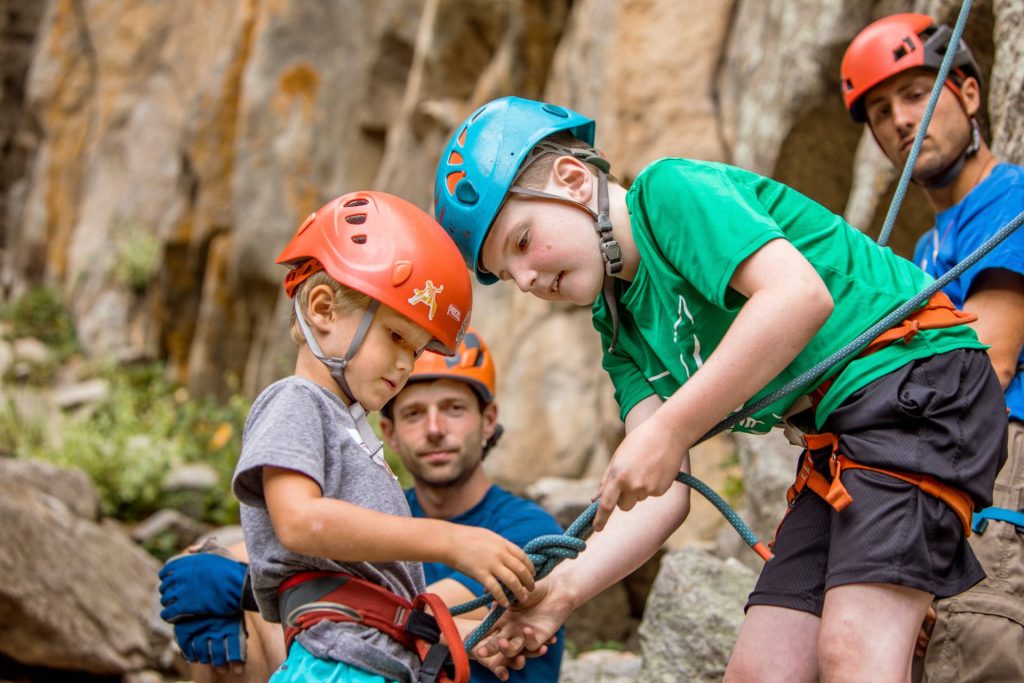Kids Rock
01 Jun 2022
Here’s how to safely transition young climbers from indoor gyms to the great outdoors.
By Julie Kailus
With its dramatic debut at the Tokyo Summer Olympics (including a fifth-place finish by Boulder native Brooke Raboutou), sport climbing finally found a spotlight. More youth than ever are giving the sport a try as the number of indoor climbing gyms in North America hits an all-time high. Kids and teens are flocking to gyms as part of classes, teams and climbing-minded friend groups.
After all that gym time, what happens in summer? Is it possible—and safe—for newly anointed climbers to take their skills outside, especially when their families may not have the gear and know-how to get on the rocks?
Enrolling kids in a youth summer camp with a local gym or outfitter like Movement, ABC Kids Climbing or Colorado Mountain School can definitely make the gym-to-crag transition easier. ABC Kids Climbing offers several camps that help kids aged 6 to 17 transition from the gym to outdoors with topics including risk assessment and decision making, the difference between climbing on plastic and climbing on sandstone or granite, communicating and interacting in the natural environment, leave-no-trace principles, and history lessons about the climbing areas they visit.
ABC works closely with Boulder Climbing Community, a nonprofit focused on Front Range climbing access, to transition and engage young climbers in outdoor stewardship through climbing-access trail building and maintenance, says ABC program director Robyn Erbesfield-Raboutou (Brooke’s mom). “Stewardship is a great place to start even prior to climbing in the outdoors, as there is a wide breadth of stuff to do and learn and it’s fun for not just the kiddos but for the whole family to get outside together.”


Boulder County is home to plenty of beginner crags, including progressive rock faces in the Flatirons and Boulder Canyon—but tread lightly. Erbesfield-Raboutou highly encourages families to seek formal instruction before making the transition.
“It’s like a new driver getting on the highway for the first time,” says Joshua Hill, program supervisor at Boulder Rock Club. “You’ve entered the world of your own judgment. You don’t want to just hop out of the gym once you learn to top-rope and belay.”
Getting a belay certification from your child’s gym, which indicates you can safely anchor your child while climbing, is a good place to start, but Hill warns: “Nothing we do in climbing is safe. So, everyone needs to know what’s going on, even down to a parent who is just there to belay but needs to know how to take the slack out of the line.”
Here are some creative ways to transition from the relative safety of indoor climbing to the outdoor environment.
Try via ferrata.
For families with very little experience, via ferrata (Italian for “iron path”), which incorporates metal rungs, ladders and safety wire into tricky terrain, is a great way to get outside on the rock together. This assisted-climbing activity combines hiking, scrambling and climbing, all while harnessed and clipped into a rope as you move from rock face to face along a guided route.
“If your experience level is, you’ve watched ‘Free Solo’ and have been in a gym once or twice, it’s a good entry-level activity,” Hill says. “It’s a more built environment with ladders and rungs, but it’s a nice equalizer.”
Erbesfield-Raboutou says guided via ferratas are a great way for families to climb together even if they’re not all avid climbers. “Professional via ferrata operators are growing, and the discipline is gaining popularity,” she says.
Colorado’s home to numerous via ferratas, including nearby options in Estes Park and Idaho Springs.
Build a backyard setup.
To keep a closer eye on your kids outside of their indoor climbing classes, consider a progressive backyard setup where everyone can participate in family climb time and practice on vertical terrain similar to gym walls.
If you’re a serious DIYer, it’s possible to engineer a functional setup, but consider calling in the local pros: Eldorado Climbing Walls, or Eldowalls. “They do fantastic work with home-wall builds to give you the right angles and structural integrity,” Hill says.
Or you could build the base and work with a local route setter to place holds in challenging but achievable patterns that simulate real rock projects.
Make bouldering an adventure.
The bouldering section is one of the most accessible and popular parts of climbing gyms; climbers don’t need ropes and work on short routes leveled by color with a big mat designed to catch frequent falls.
In summer, moving this activity outdoors can provide fun family time. Hill says bouldering presents a greater injury risk because ankle rolls are prevalent. “But it’s a great option to get outside,” he adds. “It’s more of a social event, there’s a shorter approach and it’s easier to pick your own adventure and be more engaged as a family.”
Check out popular intro bouldering spots via the Mountain Project app. And if you’re not quite ready to invest in gear, you can rent it for the summer at Boulder’s Neptune Mountaineering.












